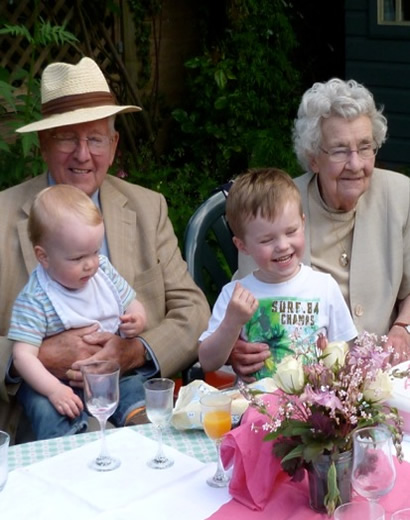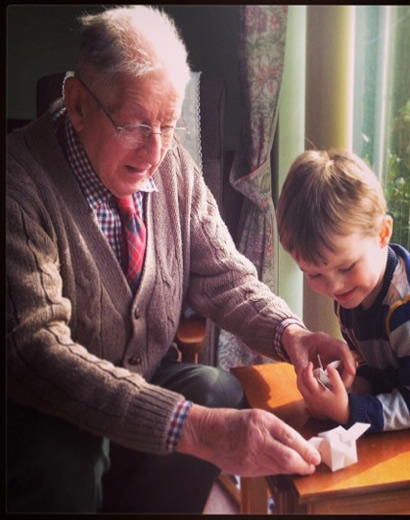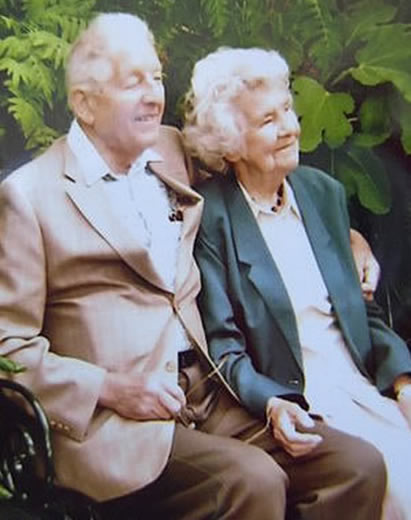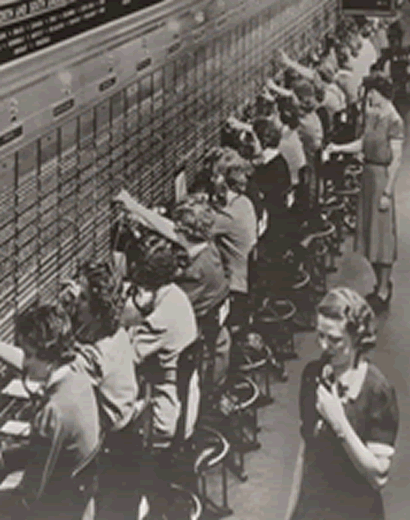Blind Dates
When the public telephone service was first introduced it was inevitable that men and women would get to know each other over the phone and occasions would arise when they wanted to meet in person. They were not known as "blind dates" in those days but that is what they were and as the service grew so did this form of meeting. By the time of the 39-45 war, when normal social functions were more difficult because of lack of opportunity, blind dates were very popular and when the G.I.s came over with their fascinating drawl and far more money than our servicemen, they used all the means they could to get a date. Telephone operators were top favourites simply because they came into telephone contact with callers and directory enquiry operators were particularly vulnerable. In London where all D.Q. calls were concentrated on one large exchange in Grays Inn Road, it was not unknown for a blind date to follow a friendly enquiry conversation . Some girls used to arrange to meet outside the building so they could look out the window and see if their suitor looked the right type, before going down to the meeting. All this informal chatting by operators was definitely not allowed by the very strict supervision standards of the day but it went on, nevertheless. I knew of one case at a local exchange where a serviceman "chatted" up an operator but didn’t get her name. He was so persistent that he was eventually put on to the Supervisor. He told her such a plausible and heartbreak story that she softened and went round the girls to try and find who he had spoken to! I, too, experienced a blind date but before I tell the story, I must give some explanation of auto to manual working at that time.
To enjoy all the Images Click on Large image and then the arrow for slide show
When the first automatic exchange was introduced at Holborn in London in the mid 1920s there was an immediate problem of connecting callers to all the surrounding manual exchanges. This was first done by connecting the caller to the operator at the called manual so that the caller could ask her for the number wanted and she could connect him to the multiple.(See Slide four of Images above) As automatics grew in number , better ways of completing this type of call were adopted and in the 1930s in large networks the Coded Call Indicator (CCI) working was introduced. With this system CCI equipment was fitted at the calling auto exchanges that was able to record and store the digits dialled by the caller and then wait until the call could be accepted by the manual exchange. At the called manual special CCI B positions each with 36 connecting cords, were fitted with a display panel in the operators keyshelf.
When an operator became free the calling auto could send the number in the form of light and heavy current codes and bring up the number on the operators display panel. She could then connect the call to the multiple or send back engaged code as the case may be. There was no need for the operator to enter the call and it was very fast operating, hence the large number of cords, but when it was overloaded it caused problems because the calls queued up back at the auto causing floor alarms to alert the engineer to the problem. During the war this could easily happen immediately after an air raid or VI or V2 incident when hundreds of callers would call to see if their friends and relatives were O.K. and this was very common
After the war early in 1947 I was an engineer at Palmers Green exchange in north London when a floor alarm indicated that there was trouble on the CCI equipment. On investigation , I found it was due to delay on calls to the nearby Tudor manual exchange at Muswell Hill., a few miles away. I called the manual and asked to speak to the Testing Telephonist (TT) who had the job of dealing with service enquiries. When I asked if they were busy she light heartedly replied that “she” wasn’t ! As you can imagine, one thing led to another and we arranged to meet outside a sweetshop in Muswell Hill. I said I would wear a multicolour scarf so she would know me , and she has always laughed because it turned out to be a sombre woollen tartan scarf that I wore because of the terrible weather of that winter. I recall we went to the pictures at the local A.B.C. cinema and so started our long friendship with marriage the following year. Today over sixty four years later with 2 children , seven grandchildren and four great grandchildren, we always have a chuckle when young people talk about blind dates and think what our family owes to the complications of Coded Call Indicator working!
All images and text are owned by H.J.Brown. Permission must be obtained from H.J.Brown to reproduce any of the material on this site. Contact H.J.Brown
To enjoy all the Images Click on Large image and then the arrow for slide show
When the first automatic exchange was introduced at Holborn in London in the mid 1920s there was an immediate problem of connecting callers to all the surrounding manual exchanges. This was first done by connecting the caller to the operator at the called manual so that the caller could ask her for the number wanted and she could connect him to the multiple.(See Slide four of Images above) As automatics grew in number , better ways of completing this type of call were adopted and in the 1930s in large networks the Coded Call Indicator (CCI) working was introduced. With this system CCI equipment was fitted at the calling auto exchanges that was able to record and store the digits dialled by the caller and then wait until the call could be accepted by the manual exchange. At the called manual special CCI B positions each with 36 connecting cords, were fitted with a display panel in the operators keyshelf.
When an operator became free the calling auto could send the number in the form of light and heavy current codes and bring up the number on the operators display panel. She could then connect the call to the multiple or send back engaged code as the case may be. There was no need for the operator to enter the call and it was very fast operating, hence the large number of cords, but when it was overloaded it caused problems because the calls queued up back at the auto causing floor alarms to alert the engineer to the problem. During the war this could easily happen immediately after an air raid or VI or V2 incident when hundreds of callers would call to see if their friends and relatives were O.K. and this was very common
After the war early in 1947 I was an engineer at Palmers Green exchange in north London when a floor alarm indicated that there was trouble on the CCI equipment. On investigation , I found it was due to delay on calls to the nearby Tudor manual exchange at Muswell Hill., a few miles away. I called the manual and asked to speak to the Testing Telephonist (TT) who had the job of dealing with service enquiries. When I asked if they were busy she light heartedly replied that “she” wasn’t ! As you can imagine, one thing led to another and we arranged to meet outside a sweetshop in Muswell Hill. I said I would wear a multicolour scarf so she would know me , and she has always laughed because it turned out to be a sombre woollen tartan scarf that I wore because of the terrible weather of that winter. I recall we went to the pictures at the local A.B.C. cinema and so started our long friendship with marriage the following year. Today over sixty four years later with 2 children , seven grandchildren and four great grandchildren, we always have a chuckle when young people talk about blind dates and think what our family owes to the complications of Coded Call Indicator working!
All images and text are owned by H.J.Brown. Permission must be obtained from H.J.Brown to reproduce any of the material on this site. Contact H.J.Brown





